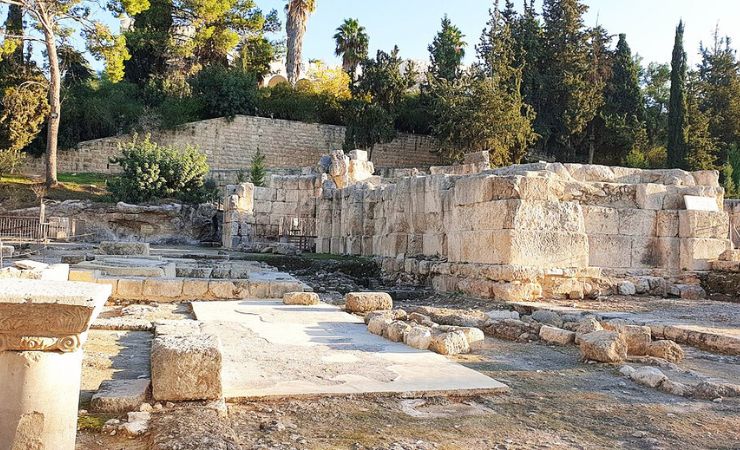Emmaus Nicopolis: Tracing the Ancient Footsteps of Faith
Emmaus is one of the most intriguing and debated sites in Christian history. Mentioned in the Gospel of Luke as the village where the resurrected Jesus appeared to two of his disciples, Emmaus has been a focal point for both pilgrims and scholars. The exact location of Emmaus, however, remains a topic of scholarly debate, with several sites proposed based on biblical, historical, and archaeological evidence.

Location
Emmaus is generally believed to be located west of Jerusalem. The distance and descriptions provided in the Bible have led scholars to propose multiple sites as the true location of Emmaus. The three main contenders are Emmaus Nicopolis, Qalunya/Motza, and El Qubeibeh.
Biblical context
The story of Emmaus is found in the Gospel of Luke, chapter 24:13-35. After the resurrection, Jesus appears to two disciples traveling from Jerusalem to Emmaus, a village about 60 stadia (roughly 7 miles) away. The disciples do not recognize Jesus until they share a meal, during which he breaks bread and reveals himself to them. Astonished, the disciples return to Jerusalem to share the news.
Now that same day two of them were going to a village called Emmaus, about seven miles from Jerusalem. They were talking with each other about everything that had happened. As they talked and discussed these things with each other, Jesus himself came up and walked along with them; but they were kept from recognizing him.



The Debate Over Emmaus' Location
The exact location of Emmaus is undetermined. Some of the suggested sites include:
Emmaus Nicopolis
Location: Approximately 15 miles (25 kilometers) west of Jerusalem.
Support: Traditionally identified by Eusebius and other early Christian writers, Emmaus Nicopolis is a significant site with extensive Roman and Byzantine ruins, including churches and a monastery. The name “Nicopolis” was added after the city was rebuilt by the Romans following the Bar Kokhba revolt. This location was identified by Miriam Bawardi (1846-1878) a Carmelite nun born in the Galilee in 1878 following a vision she had of this place.
Challenges: The distance of Emmaus Nicopolis from Jerusalem is double that described in the Gospel of Luke, leading some to question its identification as the biblical Emmaus.
2. Qalunya/Motza
Location: About 3.5 miles (5.5 kilometers) west of Jerusalem.
Support: Some scholars propose Qalunya/Motza as Emmaus due to its proximity to Jerusalem and historical significance as a Jewish settlement during the Second Temple period. Recent archaeological findings have also suggested this area as a possible candidate for Emmaus.
Challenges: The proximity to Jerusalem is less than the 60 stadia mentioned in the Bible, which could mean that the site does not match the Gospel’s description.
3. El Qubeibeh
Location: Approximately 7 miles (11 kilometers) northwest of Jerusalem.
Support: El Qubeibeh has been a traditional site of pilgrimage since the Crusader period, with a Franciscan church marking the spot. The distance from Jerusalem aligns more closely with the biblical account, making it a plausible candidate.
Challenges: There is limited archaeological evidence to definitively identify El Qubeibeh as the biblical Emmaus, and its tradition as Emmaus only dates back to the Middle Ages.
Emmaus Nicopolis: Historical Background
Ancient Origins and Roman Era
Emmaus Nicopolis was originally a small village known simply as Emmaus. Its name, derived from the Hebrew word hammat, meaning “hot springs,” suggests the presence of thermal waters in the area. During the Hellenistic period, it gained strategic importance, particularly during the Maccabean Revolt, when it was fortified by the Seleucid general Bacchides around 160 BCE.
In 4 BCE, after the death of Herod the Great, a Jewish rebellion led by Judas son of Hezekiah broke out, and the Romans responded by destroying Emmaus. However, it was later rebuilt in about 220 CE and expanded into a major town during the reign of the Roman Emperor Vespasian, following the First Jewish-Roman War. It was at this time that the town was renamed Nicopolis, meaning “City of Victory,” to commemorate the Roman victory.
Byzantine Period
The Byzantine era saw Emmaus Nicopolis emerge as an important Christian pilgrimage site. Eusebius of Caesarea, the famous early Christian historian, identified Emmaus Nicopolis as the biblical Emmaus. The site became a focal point for Christian worship, and by the 4th century CE, a significant church had been built there to commemorate the appearance of the risen Christ to the two disciples. During this period, Emmaus Nicopolis grew into a bustling city, and its ecclesiastical significance was recognized throughout the Byzantine Empire.
Islamic and Crusader Periods
Following the Islamic conquest of the Levant in the 7th century, Emmaus Nicopolis, like many other Christian sites, experienced a decline. However, it retained its religious significance. During the Crusader period, the site was partially restored, and a Crusader church was built on the ruins of the earlier Byzantine structures.
Mamluk and Ottoman Periods
The Mamluks, who controlled the region from the 13th to the 16th centuries, did not focus much on the site, leading to further decline. However, during the Ottoman period, the area was recognized once again for its historical and religious significance. The ruins of Emmaus Nicopolis attracted the attention of scholars and explorers.
The State of Israel Era
the site of Emmaus Nicopolis is currently under the care of the Catholic Community of the Beatitudes, a monastic and lay religious community that has been involved in the preservation and management of the site. They have worked to restore and maintain the ruins, ensuring that the site remains accessible to pilgrims and visitors. The community also operates a guesthouse and spiritual center at the site, offering a place for reflection and prayer.
Archaeological Discoveries
The site of Emmaus Nicopolis was rediscovered in the 19th century by European explorers and archaeologists, most notably Edward Robinson, who identified the ruins near the Arab village of Amwas. Systematic excavations began in the late 19th and early 20th centuries, revealing extensive ruins from the Roman and Byzantine periods, including the remains of a large basilica and other ecclesiastical buildings.
In the mid-20th century, additional excavations were carried out, uncovering more of the city’s infrastructure, including streets, mosaics, and inscriptions. These findings solidified Emmaus Nicopolis’ identification as a major urban center in antiquity and as a significant Christian site.
The following summarize the archeological findings at the site:
Byzantine Basilica
The most prominent structure unearthed at Emmaus Nicopolis is the remains of a large Byzantine basilica, which dates back to the 5th century CE. This basilica was built to commemorate the appearance of Jesus to his disciples after his resurrection. The basilica was a grand structure with three naves and a large central apse. Fragments of mosaics have been found on the floor, with intricate designs typical of Byzantine art. The basilica also contained several chapels and was likely a major center of Christian worship and pilgrimage.
Roman Bathhouse
Excavations have uncovered a well-preserved Roman bathhouse at the site, indicative of the settlement’s prosperity during the Roman period. The bathhouse includes typical Roman architectural elements such as hypocausts (underfloor heating systems), which were used to heat the floors and the baths. This structure provides insight into the daily life and luxuries enjoyed by the inhabitants during the Roman era.
Inscriptions and Mosaics
Several inscriptions in Greek and Latin have been found at the site, some of which refer to religious dedications. These inscriptions help to confirm the identity of the site as Emmaus Nicopolis and highlight its importance in both the Roman and Byzantine periods. The mosaics, apart from those found in the basilica, include both religious and secular motifs. One notable mosaic features a representation of the Eucharistic symbols, connecting the site directly to early Christian liturgical practices.
Crusader-Era Remains
During the Crusader period, the site saw a revival of sorts, with the construction of a new church and fortifications. The remains from this period include the foundations of a Crusader church, built on the ruins of the earlier Byzantine structures. This church was part of the efforts by the Crusaders to reclaim and restore Christian holy sites in the Holy Land.
Jewish Graves
The graves date back primarily to the Roman period when Emmaus was a significant Jewish settlement, particularly during the time of the Bar Kokhba revolt (132-136 CE).
Among the finds were ossuaries, small chests or boxes made of limestone, used to store the bones of the deceased after the body had decomposed. This practice was common in Jewish burial customs during the Second Temple period. Some include inscriptions in Hebrew or Aramaic, often naming the deceased. Additionally, symbols such as the menorah, a common motif in Jewish burial sites, have been found, further indicating the Jewish identity of those buried here. Additional finding were burial caves, which were used by Jewish communities throughout Judea during the Roman period. These caves typically contained multiple burial niches (loculi) where bodies or ossuaries were placed.
Nearby Sites
- Latrun Monastery: A peaceful Trappist monastery known for its serene environment and historical significance.
- Abu Ghosh: A village with ancient churches such as the Church of Resurrection, and a rich cultural history, often associated with the biblical Emmaus.
- Ein Karem – A picturesque, historic village. Home to different improtant site for Christianity such as Mary’s Spring, The Church of Visitation, John Be’Harim Church, and the .
- Yad Hashmona Biblical Village: A reconstructed biblical village offering an immersive experience into ancient Israelite life.



